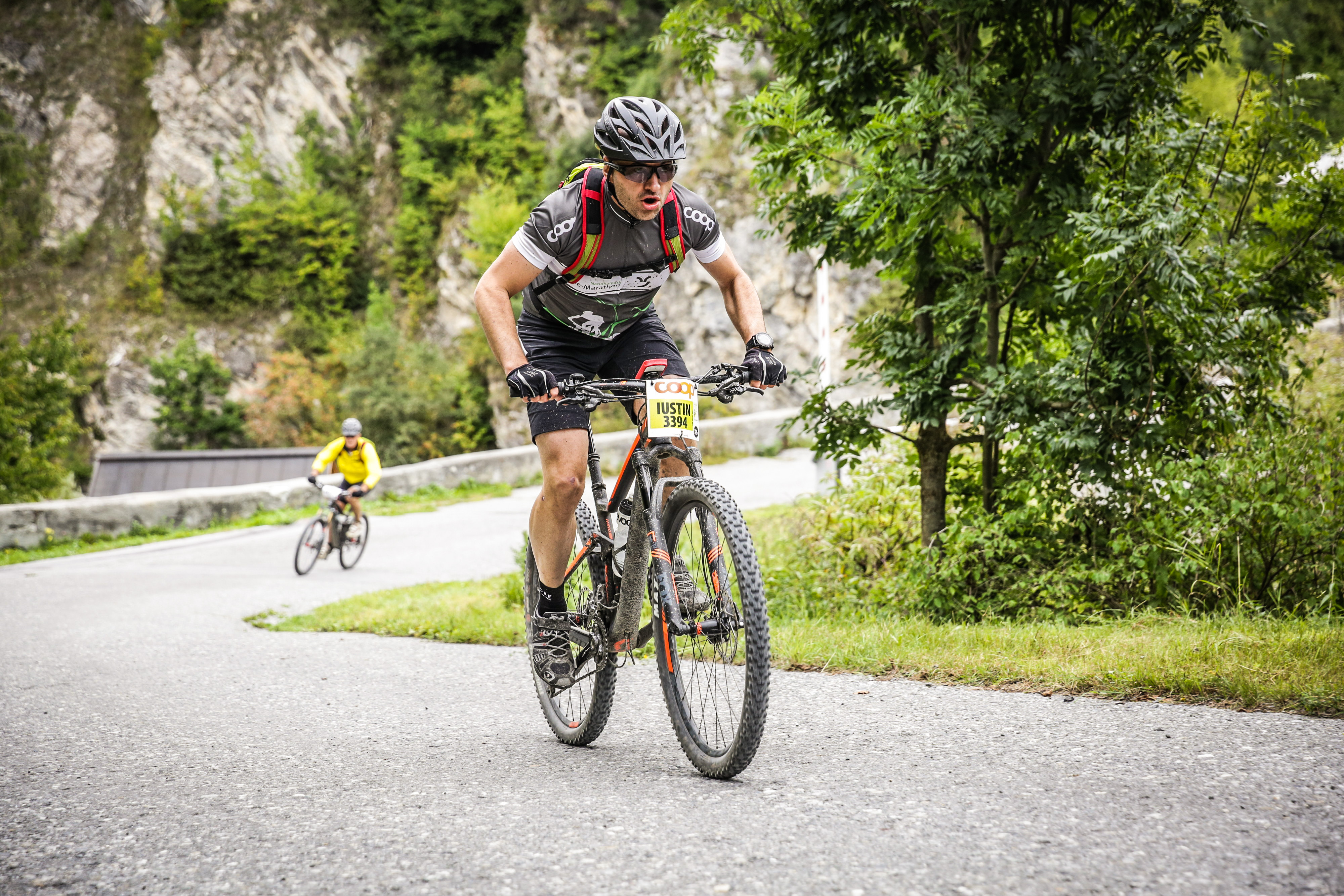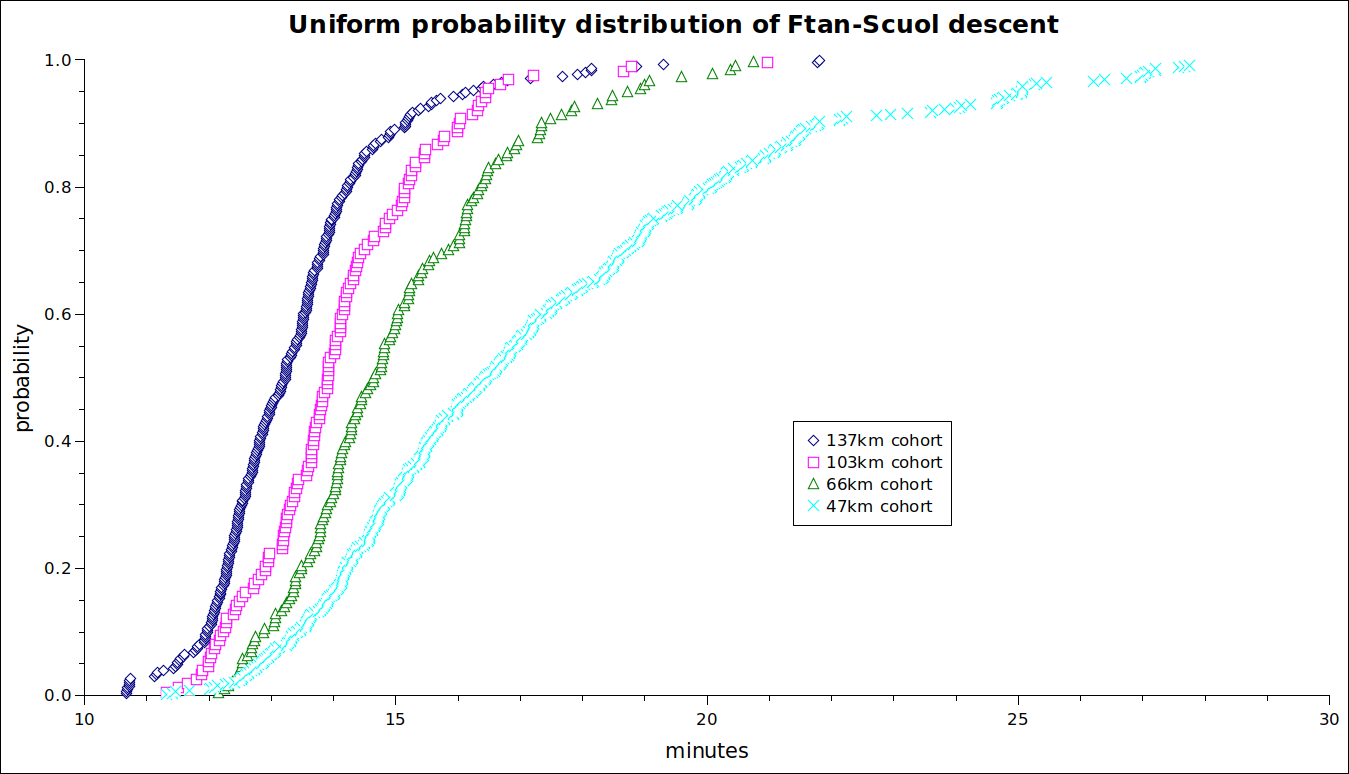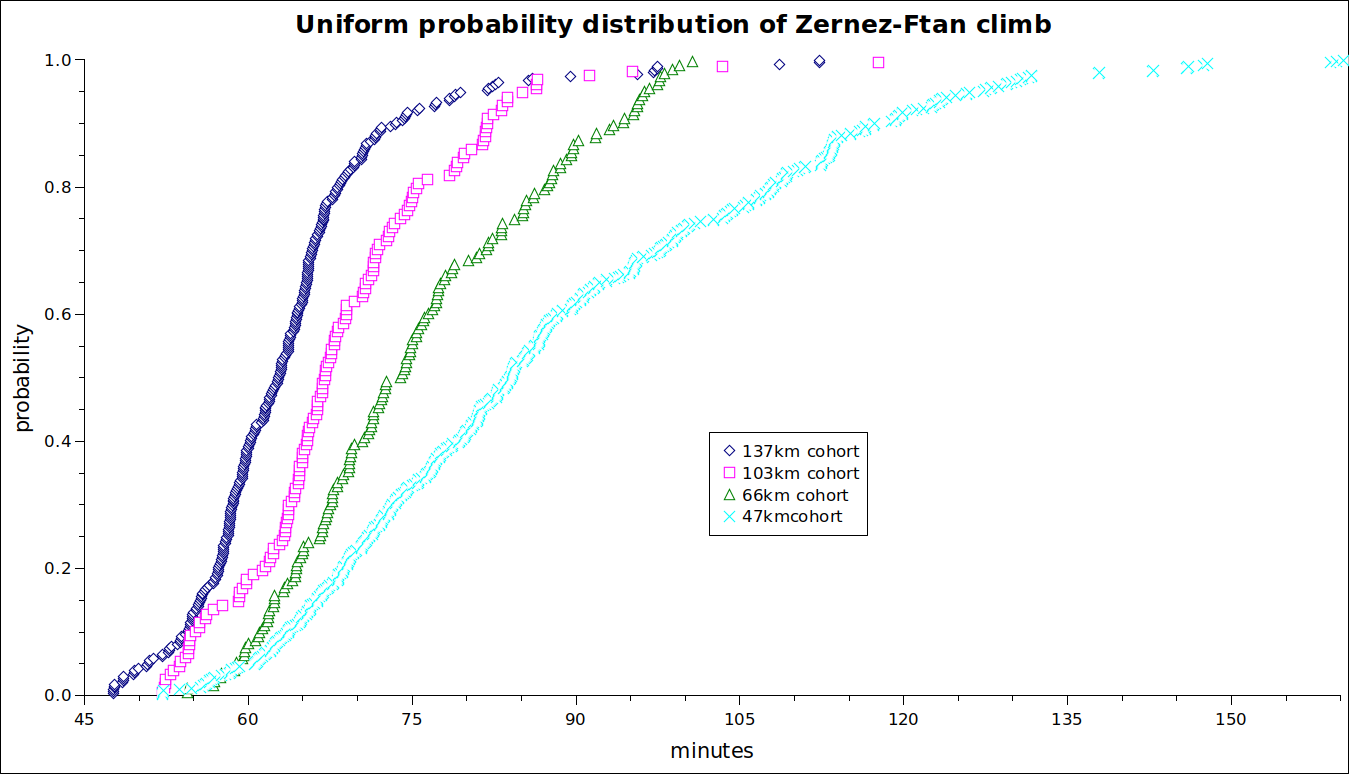Nationalpark Bike-Marathon 2018
Posted on August 28, 2018 with tags cycling. Part 4 of a 8-part series on bike races. See the previous or next posts.
Results and analysis of NBM 2018
Finally, felt like a real race - but was it?
Apologies for over the top wording, but this was the first time I actually felt like racing. In a long while, and the first time in cycling, I think. And then I saw the data and realised ouch, I’m a couch potato only, with a Couchlandrian passport.
Anyway, let’s rewind.
Race choices
After my previous very slow and unsuccessful in all aspects race, I scaled back my plans of going for a longer distance and was left with two choices: redo the 66km/1’870m route I did in 2016, or go for the shortest one - 47km/1’051m. Hmm, choices:
- For the 66km route: very nice views, actual single-trail sections.
- For the 47km route: my performance in the last race, and the fact that you can wake up at a reasonable hour (e.g. 6:30) to be at the start in time.
In the end, logic and common sense prevailed and I registered for the short route. I was in any case satisfied that even this short route had more than 1’000 meters of altitude gain, quoting from the web page:
Don’t forget: although it looks as though this stretch runs downhill all the way, there is a total of 1,051 m uphill.
So, mentally prepared for around 1’000 meters. Not quite trivial, but not hard.
Weather
A few days before the race, however, even as I was still in Zürich, I get an SMS from datasport “Please read important information about the race on their website”. I ignore this since I did check things up on the previous weekend, and go about my day.
What those news were about was actually an important topic: due to significant weather changes, all routes except the very short one were kind of cancelled—they were redirected to the short route. Another small change they did was to add a small climb at the end of the race (instead of traversing a long, modern bridge over the Inn, it goes down and through the old section of Scuol, over a small bridge, and then up again on the other side).
So, no matter how much I debated which route to register for, the end result would have been the same in any case. Everybody, including the real pros, were going to do the very short route.
And this brings up two things:
- One can now do a nice comparison across the various categories; for example, are the people who register for the 66km route (which is not part of the official Garmin Bike Marathon series) actually faster than the ones for 47km? etc.
- If the weather is bad in the mountains, it will probably be bad in the valley as well. Will I actually understand this in time to take good clothing with me? The answer, of course, not.
So I ended up with buying an extra rain cover (cheap, surplus from previous years of this event) when I picked up my number and other staff. The participant gift was a bike backpack, which was extra good because I didn’t bring mine - after all, I was (still) planning for a sunny but not too hot day, in shorts and t-shirt.
So it turns out that with the extra stuff, I did not really freeze at 7:20 in the morning as I was waiting for the train, as I was loading my bike, etc. By the time the race started, it was rain cover off, arm warmers off, so it did end up as t-shirt + shorts, just with a backpack that I was not planning on (so extra weight). Not too bad, but why do I always under-prepare?
During the race, it was perfect temperature: max recorded was 20°, but that at the start of the race, after waiting in the sun. In-race it was between 9° and 17°, with the average (including that warm 20° in the first 5 minutes) of 13.7°. Perfect for me, no complaints at all.
The race
Because I knew it’s short and not too much climbing, I started on the fast side. Because there’s no large climb at the beginning, but mostly distributed with a single medium block in the middle (~300m) and two other small ones of 50-60m, it suits me very well - I was able to use my impulse from the preceding flat/downhill to get over most small climbs, and since my profile (in Sufferfest) is “attacker”, I could do this over and over again.
So I started fast, and kept going fast—for me, that is—all along the race. I skipped first food station, and ate something during a light climb (opening an energy bar package with the teeth was new for me). The 300m climb was somewhat painful, but I was able to keep biking and not stop.
As the race was progressing, the altitude was increasing but not in the amounts I was expecting. With ~10Km left, I was still missing around 300m, so I was somewhat holding back on the small up/down/up/down sections, as I didn’t want to burn out. Turns out… there was no “1’051m” altitude. Not by far. I read this number (~1’050) in 12 places on the web site, and in only one place I read another—847m—which was wrong enough to ignore. But this is exactly what my one of my Garmin recorded (the bike computer), while the watch recorded 862m. So two separate devices, both with barometric altimeters, recording ~200m less. Enabling “elevation correct” almost doubles the gain, so not sure anymore.
In any case, I was relying on my bike computer to track well—and it usually does, less than 5% difference—so I kept reserves. This was good, because at the end of the race I was feeling actually strong instead of spent, so on the final small climb in Scuol (20m over ~250m), I was giving all that I saved for that missing altitude:

I do wonder, if I knew I can push harder, what would have happened. Faster time, or burn-out?
Overall, this felt like a race: always riding in front of or behind a group, never alone as in other races, always being pushed or trying to push. Was good, even if surprisingly crowded, at least at beginning.
Mental vs. physical toughness
One curious thing is this: at one point during a climb, in a village, there were a few people doing the cowbell thing they do in Switzerland (not sure how to call it): a ringing of the bell which is not so much melodious but very rhythmic. You can think of it as constant drum beating.
Upon hearing this, I felt quite energised and was able to increase my speed quite a bit; I don’t remember if I stood up or just went faster, but—like a couple of years back in a different race—this helped me significantly.
And this tells me that it’s not so much physical limits, but a combination of physical and mental. Doing the Sufferfest (individual workouts and also plans) helped me much this year, but how much faster would I be on long climbs if I had the right music? And no, headphones would not do it—the sounds needs to be loud, with a good bass component that you feel in the body and not so much in the ears.
Or alternatively asked, how can one get the same motivation/push from internal sources, and not from an external one? Thoughts to ponder on…
Data analysis
Timing and ranking
My official race time was 2h11m37s, 37m27.s behind first placed in age category. But the first surprise to me was the time elapsed/moving:
- elapsed (total): 2:16:25
- moving time: 2:15:18
Which means that over the entire race, I only stopped for 67 seconds. I know where these went:
- one stop to drink to glasses of Cola and eat one slice of a pie (it tasted awesome!)
- one stop on the final long descent where my chain fell off the smallest ring (very well behaved though, did not need to stop immediately, etc.) and to reseat it
Still, one minute stop over 2:15 was unheard of for me, usually I’m doing a minimum of 5 minutes or much more (15 minutes). Lesson learned, less stopping, more eating and drinking on the way.
Second surprise was that I placed much better in the rankings: at my age category, 41st out of 72. Not in the first half, but still, much better than previously. And in this range the finish times were very close; to get to place 36th (thus in the first half), for example, I would have needed to finish just 2 minutes faster, which I consider close. Alternatively said, I would need to go from 21.425km/h to 21.732km/h. In the overall rankings for the men registered at the short distance, I was 216th/515, so again a good result for me.
However, when looking at the per-segment times:
Zeit Rang Overall
Zernez: 34.32,8 33. 192.
Ftan: 1:20.00,8 39. 214.
Scuol: 17.03,4 52. 292.S’chanf to Zernez is mostly flat, with only one 50m climb, and I did well there (33/72). Zernez to Ftan is where the rest of the climbing is, and I still did (IMHO) reasonably well, 39/72. But Ftan to Scuol is downhill, and here I did atrocious, position 52/72, and time 17 minutes vs. first placed just 12 minutes. Indeed, many people were overtaking me on the downhill, many more than on the uphill. Being here not 5 minutes faster, but just 3, would have put me in 34th/72 place.
I know I lost time due to two things: the chain falling as said, but this was maybe 30s in total (had to stop from ~30-40km/h, fix chain, restart), and the fact that I had a bit too high pressure in the front tyre, and it was too jittery. But even so, I was going down in some sections with over 60km/h (61.4, more precisely). How can people go even faster? Do they have better brakes, do they know to corner better, etc. etc.? Even smaller people than me were able to go faster. Confused.
Cohort comparison
Fun question: where would I be if I would have registered in the other categories?
- If registered for 66km, I would have been place 116/169 overall, and 25/35 in my age category. Indeed, people here are faster.
- At 103km, I would have been 127/146 overall, and 38/42 age cat.
- At 137km, 305/321 overall, 102/104 my age category. Ouch ouch!
So, the only serious conclusions I can take from all this:
- Yes, people registering for longer distances are in general faster (but first overall for 47km was faster than first for 66km).
- In order of participation, first is 47km (515 men), second is the longest route (321 men), then the 66km and finally the 103km route. So logically, I should register for the 103km route, but the people there are way too fit for me, and also technically stronger: of the 146 men competing at this distance, only the last two had a longer time on the Ftan-Scuol descent (18m, respectively 20m); the majority, I think were around/under 14m.
On the topic of comparisons, one hint about descent speed can be seen from the times on this segment across the cohorts. Since there was no significant climbing, everything is skill/technique here, not fitness/endurance:

From this graph, it’s obvious that the people in the longer sections are much better: 137km is top, 103km and 66km are strong as well, but the 47km cohort is like weekend hobby. And that’s where I am, and not sure exactly how to improve.
And since I have the data, how does the Zernez-Ftan section look like? It’s the one with the climbing, but also has some descent. So:

This is interesting as well. The distributions are subtly different, but not by much:
- the 66km cohort shows two inflexions, not just one (at ~0.7 and ~0.9)
- the 103km cohort shows a much more clear early inflexion (at ~0.2)
- the 137km cohort shows a less clear jump in the top places; it seems that the top of the top are ahead of their pack significantly during the descent, but not so on the climb.
- and hobby bikers show (except for top 0.02 or so) a much more flattened curve…
Also overall interesting thing: there were a few very strong people competing in the 47km category, matching the people in the 103km, both on the climb and on the descent.
Gender distribution
And an interesting observation on male/female distribution:
- 47km: 515:107, 4.8 times more men
- 66km: 169:25, 6.8×
- 103km: 146:26, 5.6×
- 137km: 321:14, 22.9×
I’d say the first three routes are more or less the same (4.8-6.8), but the longest one jumps to almost 23× ratio. Why? The race goes from 103km/2’900m to 137km/4’026m, so the increase in altitude is in-line with the increase in length. And for the women that did compete, their time compared to men is not relatively-speaking much worse on the longer route compared to the 103km one: the 2016 results say ~24% slower at 137km, ~25% slower at 103km. For the 2018 results (all actually on the 47km), it was a constant ~10-11 minutes difference, except for the shortest route group, where it was ~20 minutes (this is hobby cycling basically, so not surprised). Anyway, found this interesting.
Lessons learned
A few very practical, easy to fix points:
- Always bring clothes for all weather.
- Always bring my backpack, since it has nice side pockets that are easy to access.
- Lose more weight - I’m still way above from where I think I should be.
- Train more consistently, in the pre-race season especially.
- Try to not stop so much, and instead switch position (seated/standing) on long climbs instead.
- The shortest race category is really a category apart - hobby bikers, whereas the other categories are more closer together from the point of view of performance. Until I get much better, maybe I should stay here…
And the last part, which I don’t know how to fix, is how to safely get better on easy downhills: both on gravel and asphalt, I was slow and was being overtaken. How does one get better here? On asphalt at least, having higher-than-ideal tyre pressure should be of no consequence (but it is on gravel). Just ride more outside? Learn to trust my brakes better? Etc.
Onwards
After all this, and after seeing how much I can improve, my enthusiasm is a bit lower (regarding my results). Anyway, my next race will not be so easy, and a repeat of a previous year route, so I’m curious how I’ll do, relative to myself. Onwards!